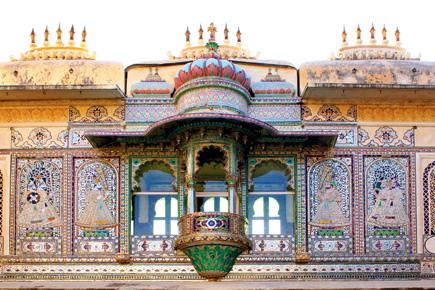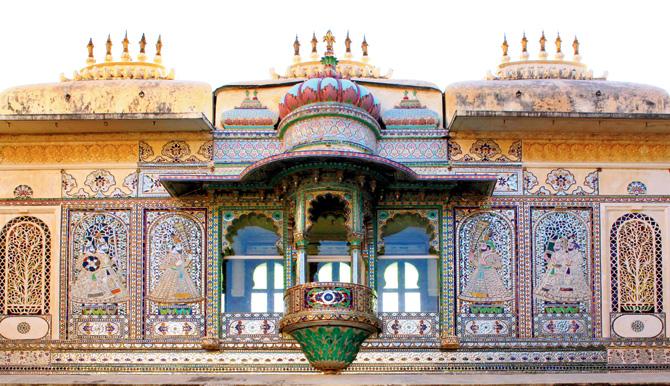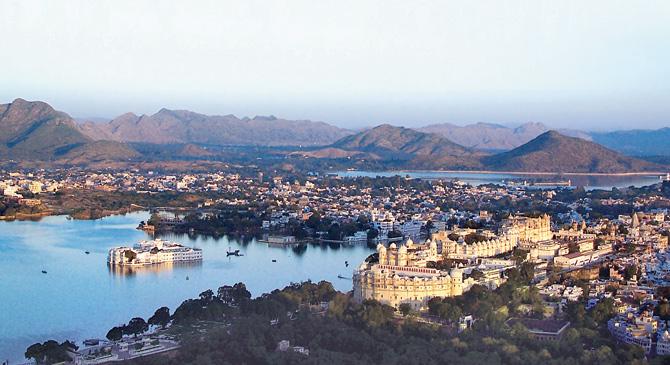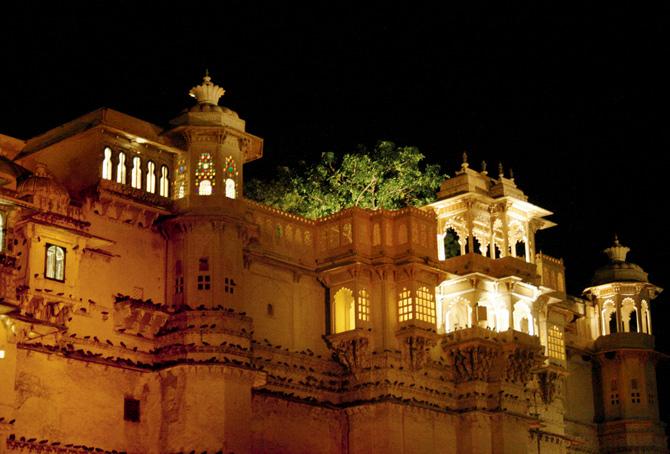If the rising mercury levels dissuade you from a trip to Udaipur and its iconic City Palace, take our comfy armchair trail of its museum ahead of a talk on its conservation efforts

The glass inlay work from late 19th century in the Mor Chowk (peacock courtyard) of the Mardana Mahal is considered Udaipur's most iconic artwork
![]() Standing flamboyant by the powder blue Lake Pichola, the 200,000-sq ft City Palace in Udaipur, a part of which now functions as a living museum, can overwhelm you even before you step into the fine celebration of Mewari regalia. Built over four centuries ago by Rana Udai Singh II, father of Rana Pratap, the old palace stands atop a low ridge, Rana’s Hill. “The museum features the architectural narrative of the Rajput Mewar styles since 16th century, borne out of patronage of 22 Maharanas, showing 13 layers of historic architectural fabric with a range of in situ (on site) artworks from different times,” observes Gurgaon-based conservation architect Dr Shikha Jain, director of DRONAH (Development and Research Organisation for Nature, Arts and Heritage), in Mumbai for a lecture at the Chhatrapati Shivaji Maharaj Vastu Sangrahalaya (CSMVS) this evening.
Standing flamboyant by the powder blue Lake Pichola, the 200,000-sq ft City Palace in Udaipur, a part of which now functions as a living museum, can overwhelm you even before you step into the fine celebration of Mewari regalia. Built over four centuries ago by Rana Udai Singh II, father of Rana Pratap, the old palace stands atop a low ridge, Rana’s Hill. “The museum features the architectural narrative of the Rajput Mewar styles since 16th century, borne out of patronage of 22 Maharanas, showing 13 layers of historic architectural fabric with a range of in situ (on site) artworks from different times,” observes Gurgaon-based conservation architect Dr Shikha Jain, director of DRONAH (Development and Research Organisation for Nature, Arts and Heritage), in Mumbai for a lecture at the Chhatrapati Shivaji Maharaj Vastu Sangrahalaya (CSMVS) this evening.

The glass inlay work from late 19th century in the Mor Chowk (peacock courtyard) of the Mardana Mahal is considered Udaipur’s most iconic artwork
ADVERTISEMENT
Jain’s lecture will present an overview of the Conservation Master Plan (CMP) for the museum, developed from 2005 to 2009 through grants awarded by the Getty Foundation in the USA, and its phased implementation thereafter. “The built spaces and specific artefacts in the museum are still strongly associated with Mewar rituals and often used in annual festivals by the royal family.
 An aerial view of the palace. Pics Courtesy/Media Office/Eternal Mewar/The City Palace/Udaipur
An aerial view of the palace. Pics Courtesy/Media Office/Eternal Mewar/The City Palace/Udaipur
So, the conservation philosophy for the complex goes beyond mere technical restoration,” says Jain, whose organisation was engaged by the Maharana of Mewar Charitable Foundation, which manages the museum and envisaged the CMP. The plan was prepared with help from a range of experts including archaeologists, historians, art conservators, curators, environmental and landscape experts. “We undertook an elaborate research along with studies of daily records of the rulers called bahidas, archival documents, maps, paintings since 16th century, on-site physical inspections and surveys including photogrammetry conducted by IIT Roorkee,” she adds.

A traditional caparisoned horse in Amar Mahal, a marble ashlar masonry palace converted into the Silver Gallery, featuring silver artefacts used for pujas, about 450 vanity items, royal transport like a buggy and elephant and horse jewellery
So far, the team has completed physical conservation works in several museum areas like Badi Pol (entrance), visitor-orientation space in Moti Chowk, facade conservation of Zenana East Face and other areas. “Several new museum galleries with conservation, cataloguing of artefacts and state-of-the-art displays are in place.

The Som Niwas Gallery presents 47 sculptures (of a total of 308 in the museum collection) of the gods, the Surasundaris, goddesses and the animal motifs/memorial stones from 9th and 10th centuries temples of Nagda in Ujjain. Pics Courtesy/Media Office/Eternal Mewar/The City Palace/Udaipur
These include Silver Gallery, Photography Gallery, Music Gallery, Sculpture Gallery and Photography storage with compactors. Three new galleries are being worked on with the intention of opening up all new collection galleries in Zenana Mahal (half of the museum) by 2018,” informs Jain.

With flowering shrubs, arched pavilions and a water basin, Baadi Mahal features an intricately-carved, Rajput-Mughal style marble palace garden, set atop the hill, offering panoramic views of the town and Lake Pichola. Apparently, it’s a favourite private palace of the Maharanas and associated with recitation rituals, Holi celebrations, etc.
On: Today, 6 pm
At: Auditorium, Museum Visitors Centre, CSMVS, Fort.
 Subscribe today by clicking the link and stay updated with the latest news!" Click here!
Subscribe today by clicking the link and stay updated with the latest news!" Click here!







